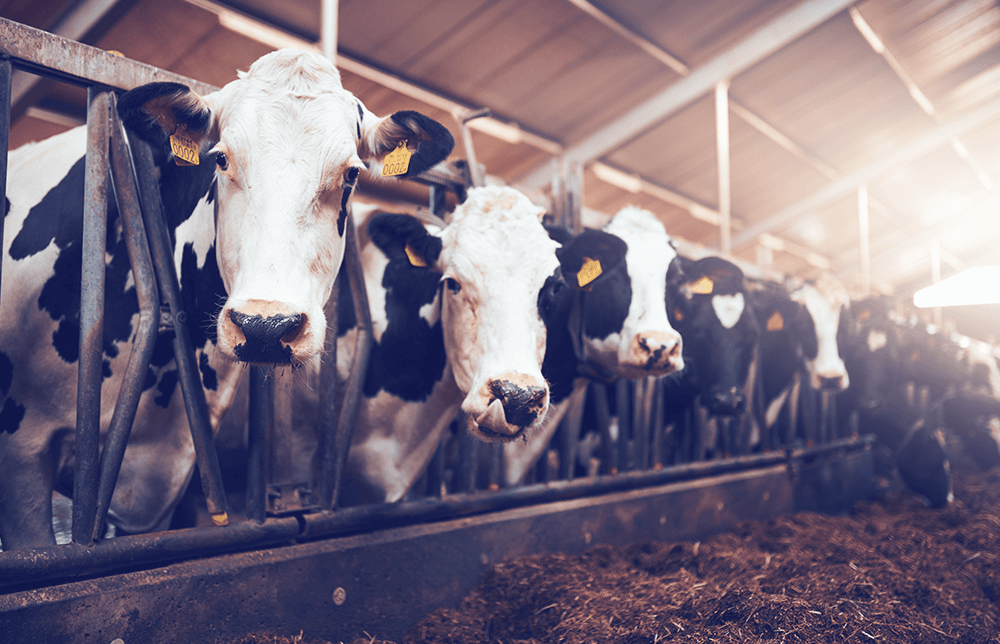Feeder Cattle Trading: How to Trade Feeder Cattle CFDs
Date Modified: 29/12/2024
Feeder cattle comprise a crucial part of the global commodities market, linked to diverse market sectors from sports equipment to farming. In this article, we'll take a look at how this important commodity is traded, its unique dynamics, and how it may make an addition to your personal trading portfolio. Let's dive in:

What Are Feeder Cattle?
Feeder cattle (GF) is a term used to refer to cattle, male or female, that have been weaned from their mothers but haven't yet reached maturity. Sometimes called store cattle as well, feeder cattle are a key input in the global agricultural market.
These young cattle are purchased by feedlot operations, where they undergo finishing, a process in which they gain weight in preparation for later sale. They are generally divided into two categories: feeder calves which are generally less than a year old, and feeder yearlings, aged between one and two years. Once they achieve the desired weight---usually between 386 and 635 kilograms---they are sold to packing plants for processing.
The price of feeder cattle is driven by various factors, including feed costs, cattle weight, and market demand for beef. For instance, an increase in feed prices, which raises the cost of growing cattle, could push up the price of feeder cattle. Demand for beef is another major influence; when beef consumption is high, feedlot operators may be willing to pay more for feeder cattle to meet production demands. Other factors like weather conditions, disease outbreaks, or shifts in global trade can also cause volatility in feeder cattle prices.
How Are Feeder Cattle Traded?
Feeder cattle can be traded in a few different ways, from the primary cash market to futures and various financial derivatives.
Cash Market
In the cash market, feeder cattle prices depend on a variety of factors including health, lot size, and physical condition. Cattle with visual signs of sickness, such as respiratory issues, are often sold at a discount due to the increased risk of death and lower chance of reaching their goal weight. On the other hand, animals in good health, or those that have undergone health maintenance programs, such as weaning and vaccinations, can attract premiums. Lot size also plays a crucial role in pricing. Prices tend to increase as the lot size grows, peaking when they match transport capacities, like truckload sizes. Beyond this threshold, prices can decrease due to limited demand and transport availability.
Futures
Another key market for feeder cattle is governed by the use of futures contracts, primarily via the Chicago Mercantile Exchange (CME). Feeder cattle futures contracts are used by producers to hedge against price fluctuations and manage risks. These contracts are based on the CME Feeder Cattle Index, which is calculated using data from across the United States' agricultural heartland. Contracts are for 50,000 pounds of cattle, and they are settled in cash based on the average prices for steers in a specified weight and grade category. This market also features derivatives, such as options and calendar spread contracts, allowing traders and investors to speculate on price movements.
Financial Derivatives
Financial derivatives play a significant role in the trading of feeder cattle, providing producers and traders with additional tools for managing price risk. In addition to standard futures contracts, derivatives such as options, calendar spread contracts, and Trade-at-Settlement (TAS) contracts are available for feeder cattle futures on the CME. These instruments allow market participants to speculate on future price movements or hedge their exposure to price changes. Options give the buyer the right, but not the obligation, to buy or sell feeder cattle futures at a predetermined price, while calendar spreads allow traders to trade on the price difference between two contract months. The use of these derivatives can help cattle producers, traders, and institutional investors reduce risk and enhance returns by locking in prices or speculating on market fluctuations. The influence of feeder cattle futures extends to broader financial markets, as they are included in indices like the S&P GSCI, which means their price movements can impact the performance of investment portfolios and funds that track such commodity indices.
Another way to participate in this corner of the commodities market via derivatives is available by CFD trading. In the world of CFD (Contract for Difference) trading, traders can participate in the price movements of feeder cattle without owning the cattle themselves or engaging in futures trading. With feeder cattle CFDs, traders can open buy or sell positions based on their expectations with regard to whether prices will rise or fall. This provides a way for investors to trade on changes in market conditions related to agricultural commodities without the need to physically handle cattle or navigate the complexities of livestock markets, but the risk of significant financial losses must be taken into account as well. Due to the use of leverage, traders are able to open larger positions than their capital outlay would normally allow, but potential losses are magnified in tandem.
Factors Affecting Feeder Cattle's Price
The feeder cattle market is influenced by various factors that influence trends on the overlying CFD market as well. Here's an overview of a few major factors impacting feeder cattle prices:
- Feeder Cattle Supply: A significant factor is the availability of feeder cattle outside finishing feedlots. Tight supply typically leads to higher prices as demand outpaces availability, encouraging heifer retention and further limiting supply.
- Feeding Margins: When feeder cattle supplies tighten, finishing feedlots often experience negative margins. During such periods, feedlots can struggle to lock in profits, especially if the cattle herd is in an expansion phase. Sustained negative margins can trigger significant market shifts, particularly after 8 to 12 months of losses.
- Feed Grain Prices: Other commodities' price trends can directly shift the market value of feeder cattle. The cost of feed, particularly corn (ZC) and barley, is a crucial factor. Lower feed costs can provide feedlots, particularly in Western Canada, a competitive advantage.
- Forex Changes: Foreign exchange rates can influence cross-border trade, particularly between Canada and the U.S., further affecting feeder cattle prices. Volatile currency movements may impact the competitiveness of exports or imports, adding another layer of complexity to pricing.
How to Analyse Feeder Cattle
Below are three different analytical strategies you can apply to the feeder cattle market:
Fundamental Analysis
Fundamental analysis involves evaluating key supply and demand factors that influence feeder cattle prices:
- Supply Metrics: Examine feeder cattle supply levels reported by the USDA. Lower supplies outside finishing feedlots, as seen in recent reports, can lead to higher prices due to tighter availability.
- Feed Costs: Monitor the prices of essential feed grains, like corn and barley. Higher feed costs can reduce feeder cattle demand as feedlots face increased operational expenses.
- Market Dynamics: Evaluate the broader cattle market, including the price of fed cattle, as it influences feeder cattle demand. Negative feeding margins at finishing feedlots can result in lower prices for feeder cattle.
Technical Analysis
Technical analysis involves using past price data to predict future price trends in the feeder cattle market:
- Price Patterns: Look for recurring trends in feeder cattle price charts, such as support and resistance levels, which could indicate future price movements.
- Volume Analysis: Assess the trading volume in futures markets. High volumes might signal strong trends, while low volumes could suggest potential reversals or price stagnation.
- Indicators: Apply technical indicators such as Moving Averages (MA) and Relative Strength Index (RSI) to gauge market trends.
Sentiment Analysis
Sentiment analysis focuses on external factors and market psychology that could impact feeder cattle prices:
- News and Events: Stay updated on relevant news, including government policies, trade agreements, or supply chain disruptions, which could affect feeder cattle prices.
- Market Mood: Assess the broader economic conditions, including consumer demand for beef and geopolitical factors, which can influence the outlook for cattle markets.
How Can I Start CFD Trading on Feeder Cattle With Plus500?
Now that you've enriched your knowledge about feeder cattle, it's time to learn about the next steps in your feeder cattle CFD trading journey:
- Keep Learning: Use our free Plus500 Beginner's Guide to deepen your understanding of CFD tradings' dynamics and risks before entering the arena.
- Register, Get Verified, Practise: Open your Plus500 trading account, get verified, and test your skills risk-free on our trading platform's unlimited demo mode.
- Jump In: After practising trading in demo mode, search GF on the platform to find feeder cattle CFDs, decide whether to go long or short, and put risk management strategies in place. Change your trading approach as needed, while always remembering that CFD trading carries significant financial risks.
Conclusion
Feeder cattle are a crucial component of the global commodities market, and their price movements can be traded via the use of CFDs. By understanding the market factors, price dynamics, and trading strategies outlined in this guide, you can make more informed decisions about how to integrate feeder cattle CFDs into your portfolio. However, due to the inherent volatility and risks associated with this market, it's crucial to conduct a thorough analysis and apply effective risk management techniques.
If this type of trading interests you, trade feeder cattle CFDs with Plus500.
FAQs
Feeder cattle CFD prices are influenced by factors like feed costs, cattle supply, demand for beef, weather conditions, and currency fluctuations.
Feeder cattle CFDs allow traders to trade on price movements without owning the underlying asset, while futures contracts involve commitments to buy or sell at a future date.
CFD trading carries significant risks, including market volatility, leverage exposure, and potential for substantial financial losses.
Yes, feeder cattle CFDs are available for trading on platforms like Plus500, allowing traders to speculate on price changes without physical cattle ownership.
Related News & Market Insights
Get more from Plus500
Expand your knowledge
Learn insights through informative videos, webinars, articles, and guides with our comprehensive Trading Academy.
Explore our +Insights
Discover what’s trending in and outside of Plus500.
Stay up-to-date
Never miss a beat with the latest News & Markets Insights on major market events.


